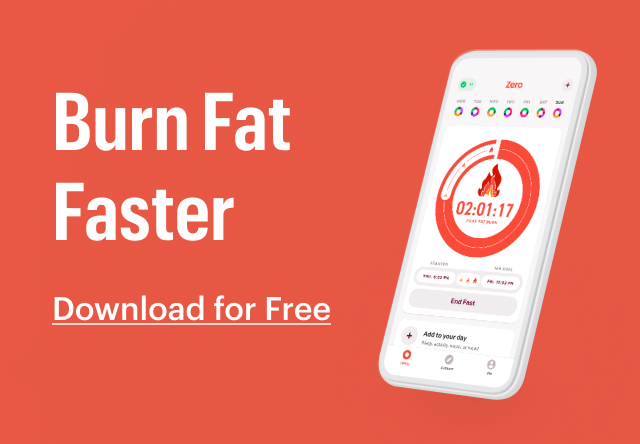Written and medically reviewed by Rich LaFountain, PhD
16:8 intermittent fasting involves a 16-hour fasting window and an 8-hour eating window. It’s a popular, evidence-based approach to improving your health, and the best part is you can see real results in just one month!

Potential 16:8 Intermittent-Fasting Results in 1 Month
16:8 intermittent fasting is one of the most well-researched fasting protocols for achieving healthy weight loss and metabolic-health gains. Results of 16:8 intermittent fasting that you can look forward to realizing in a few short weeks include weight loss, enhanced fat burning, improved sleep, and more.
Weight Loss
Weight loss is the number-one reason people try intermittent fasting. Compared to traditional diets involving calorie restriction, also known as calorie counting, intermittent fasting is easier to maintain and adherence is better. The best part is that people who practice intermittent fasting do not have to deprive themselves, track their meals, or count calories to lose weight. If you adopt a 16:8 intermittent-fasting approach to your nutrition, you are likely to spontaneously reduce your energy intake by approximately 20–30% or 350–500 calories.
Within a month of consistent 16:8 intermittent fasting, you can expect to lose 2–5% of your body weight. A safe rate of weight loss will typically average out to about 1–2 pounds per week, so develop a routine for weighing yourself once a week. The best time to do this is in the morning after you’ve used the bathroom.
Improved Insulin Sensitivity
16:8 intermittent fasting will reduce your insulin and blood-glucose (blood sugar) levels to a natural baseline during each of your fasts, which leads to better insulin sensitivity and may result in lower diabetes and chronic disease risk. In a 4-week 16:8 intermittent-fasting trial, insulin levels were reduced 3.1μU/mL, or 25%. The impact of 16:8 intermittent fasting on insulin sensitivity is an important benefit, since evidence indicates that insulin resistance and metabolic dysfunction are underlying causal factors in a majority of the chronic age-related diseases.
Enhanced Fat Burning
Each person’s fat-burning potential differs based on factors like nutrition, exercise, sleep, and stress. For example, if you exercise regularly, your body will be better at burning fat than someone who is less well trained.
Fasting for at least 12–16 hours enables your body to transition into a fasted state, which boosts your innate fat-burn rate. Consequently, 16:8 intermittent fasting helps your body get better at burning fat so that you can be more flexible and efficient in metabolically switching between burning glucose or fat to meet your energy needs. People who improve their metabolic flexibility with intermittent fasting and exercise tend to be healthier and have more success maintaining a healthy body weight.
Better Appetite Regulation
Research has suggested that 16:8 intermittent fasting can play a role in improving appetite regulation. The structured eating window of the 16:8 method may contribute to better control over food intake and often reduces the number of meals and snacks consumed. Over time, intermittent-fasting protocols like 16:8 will help you become more attuned to discerning true hunger and satiety cues.
16:8 intermittent fasting does not require forced deprivation during your eating window; instead, and especially with the help of partners like Zero, you can develop a more mindful approach to eating as you become more accustomed to distinguishing between genuine hunger and eating out of habit or boredom. While research in this area is ongoing, some studies suggest that intermittent fasting, including the 16:8 pattern, may positively shift hormones related to hunger and satiety, such as ghrelin and leptin. Other research suggests that fat metabolism and ketone production may reduce appetite. These hormonal changes could potentially contribute to a more balanced and regulated appetite, leading to improved weight-loss results and maintenance.
Increased Energy and Improved Focus
Many individuals practicing 16:8 intermittent fasting report improvements in energy levels, mental health, and cognitive function. When you fast, your body flips the metabolic switch away from using glucose and towards burning more fat, which contributes to more stable energy levels. Furthermore, by avoiding large fluctuations in blood-sugar levels associated with standard Western-diet eating practices, 16:8 intermittent fasting also helps stabilize energy levels.
Studies also suggest that intermittent fasting enhances mitochondrial health and function so your cells are more capable of producing energy. Both animal studies and human studies demonstrate that intermittent fasting promotes metabolic function, mitochondrial health, and energy stability that improves cognition and focus.
Digestive Reset
Your digestive system works hard each and every day, and people rarely consider allowing it time to rest. Fasting is a great way to give the digestive system a break from processing and breaking down food. Some research indicates prolonged fasts are helpful in facilitating digestive rest and reset because the cells that make up your gut lining can turn over and regenerate in a few days.
However, studies have shown that shorter fasts of around 16–24 hours promote positive changes in the gut microbiome, offering digestive benefits of intermittent fasting without the need for an extended multi-day fast. If you want to learn more about fasting to reset the health of your digestive system, check out this article.
Sleep Improvements
If you align your eating window with daylight and begin your fast close to sunset, 16:8 intermittent fasting can improve your sleep quality. One of the most immediate changes that occurs when you adopt this eating pattern is a reduction or elimination in late-night snacking. Your body is less receptive to food, especially food high in carbohydrates, after sunset. Intermittent fasting helps you to stop eating 2-4 hours before bed, thereby helping you to have better-quality sleep. How this works is still unclear, but fasting improves blood-sugar regulation and insulin sensitivity, which are factors linked to sleep stability.
Stable blood-sugar levels throughout the fasting and eating windows may help prevent disruptions in hormones that play a role in sleep, such as cortisol and melatonin.
Metabolic Adaptations
The 16:8 intermittent-fasting approach has been associated with several positive metabolic health adaptations beyond weight loss and improved insulin sensitivity. 16:8 intermittent fasting can positively impact not only biomarkers like glucose and insulin but also triglycerides and blood pressure. Moreover, 16:8 intermittent fasting may lead to favorable changes in lipid profiles according to randomized controlled trial data, including decreased levels of triglycerides and improved cholesterol levels. The 16:8 intermittent fasting approach, therefore, shows promise as a lifestyle intervention that supports weight management and metabolic-health improvements.
Four-Week 16:8 Intermittent-Fasting Results Breakdown
Across four weeks of 16:8 intermittent fasting, you’ll notice results do not happen all at once. In each of the four weeks throughout your month-long 16:8 experience, you’ll recognize new, exciting health adaptations and benefits. Start by joining Zero’s 28-Day Fasting Challenge to add some accountability and motivation that will last you the whole month.
Week 1
Already in your first week, you are likely to lose some weight. Some of this weight loss may be what’s referred to as “water weight,” so it’s important to stay on top of your hydration. Make a point to consume roughly 35 ml/kg body weight, or drink half an ounce of water for every pound you weigh.
Zero can help you to track your weight-loss progress against your weight-loss goal. Just hop on the scale first thing in the morning, after you use the bathroom. You don’t need to do this every day; pick one or two days out of the week when it will be easy to make this part of your morning habit stack. Then, get started and stick with it!
Week 2
By week two, you should be settling into your 16:8 intermittent-fasting practice. Some of the challenges associated with reaching your 16-hour target, like hunger, are likely waning. By the end of week 2, you will probably notice that you’re making progress towards your weight-loss goal but are not plagued by the difficulties and forced deprivation of traditional calorie-counting diets.
If you had additional reasons for trying intermittent fasting, such as back pain, joint issues, or even snoring, you may start to notice some improvements already in week two. At the end of this week, celebrate your 14-day streak. Zero will help you visualize your success across weeks one and two if you tap into the Me tab (bottom right inside the app).
Week 3
By week three, you should be experiencing considerably less hunger and finding it increasingly easier to reach your 16-hour fast goal. Your energy levels have probably stabilized, and you may now wonder how or why you weren’t doing 16:8 intermittent fasting before. You may feel tempted to increase your fast duration now that things are feeling easier, but it’s important to try 16:8 intermittent fasting for the full month to maintain consistency.
If you want to make adjustments and refine your habits, go ahead, but it’s ideal to allow a full four weeks for your body to get accustomed to the change in your routine and eating pattern. People tend to find that they continue to experience new benefits beyond 1 month and as late as three months or more after they first take up 16:8.
Weight loss is one of the most common intermittent-fasting results. Even if you have not seen huge reductions in your weight by week three, know that you are improving your health. Research reports that people within a healthy BMI range may not reduce body weight significantly with intermittent fasting — and that’s okay! In fact, it’s better that intermittent fasting naturally produces weight loss only in those individuals that can benefit from a reduction in body weight. After all, the number on the scale is not the only metric of health.
Week 4
Research indicates that one-month weight loss is, on average, 2–5% of your total body weight. An ideal weight-loss rate is typically about 1–2 pounds per week. Rapid weight loss can result in more muscle mass loss, whereas healthy weight loss will preserve more muscle as more fat will be burned for energy.
After four weeks of consistent fasting, research shows that you should have measurable improvements in blood-glucose levels, insulin levels, insulin sensitivity, and blood pressure to accompany favorable changes in your body weight (assuming you had some excess weight to lose). The best part is that you did all of this without having to log a single meal or count a single calorie.
Factors That Influence Intermittent-Fasting Results in Month One
While intermittent fasting is a sustainable habit that can improve your overall health and metabolic function, individual results with intermittent fasting will vary.
Starting Point
Results with 16:8 intermittent fasting will vary based upon your starting point. If you’re accustomed to eating an early breakfast and a late-night snack before bed, it may take some time to adjust to a 16:8 intermittent fasting schedule. The best way to achieve success is to make sure you’re starting your fast at least 2–4 hours before you go to bed and sleeping for a solid 7–9 hours. In doing so, you’ll improve your sleep quality and duration while you simultaneously shrink the amount of time you’ll need to put off breaking your fast the next day.
Consistency
Consistency is essential for establishing a solid intermittent-fasting habit. In your first month, you should strongly consider making intermittent fasting part of your daily routine. Early on in your habit formation, it’s actually better to be more rigid and avoid skipping days. However, as you become more experienced and the habit solidifies, you can manipulate your intermittent-fasting habit and adjust or skip days when necessary; rigidity is not as important to long-term habit maintenance.
Nutrition and Diet
The foods you eat will impact your fasts and the results you see from them. Focus on eating high-quality, minimally processed foods and emphasize lean protein at each of your meals and snacks so that you have the nutritional resources you need to effortlessly cruise through your 16-hour fast.
Caloric Intake
One of the benefits of intermittent fasting is that, during your eating window, you can eat until you’re feeling full and satisfied. It’s actually important to do this because intermittent fasting usually causes an unintentional reduction in energy intake, and if your energy deficit becomes too large, it can cause hunger and cravings during your fasts. Even worse, your body may compensate by lowering your basal metabolic rate, which is how many calories you burn at rest, and may even compromise your lean muscle mass. So, be sure you’re not heavily restricting during your eating window!
Activity Level
Activity, a.k.a. exercise, is a complementary habit that helps you get even more out of your intermittent-fasting practice. Physical activity increases your metabolism, which can help to facilitate metabolic switching and enhance your fat-burn rate while fasting, particularly after you’ve fasted 12–16 hours. In addition, exercise will signal to your body that you need to prioritize the maintenance and growth of muscle tissue so your body opts to burn stored fat rather than pulling protein from your muscles.
Sleep Quality and Stress Management
Intermittent fasting lends itself well to improving habits around sleep. 16:8 intermittent fasting provides added incentive to stop eating a few hours before bed, which can improve levels of hormones that influence sleep transition, like melatonin. And while rest is important for growth, so is stress — as long as it’s the temporary kind, as with exercise and intermittent fasting.
Chronic stress from work, relationships, scheduling, or finances can be more destructive to your metabolic function and can produce weight-loss resistance. Therefore, it’s important to set aside time to restore mentally and physically so you can break chronic stress cycles and experience the full benefits of fasting.
Age and Gender
Age and gender are less in your control than other factors like activity or sleep. However, 16:8 intermittent fasting is a great way to maintain your metabolic health regardless of age or gender. Make sure to eat high-quality foods during your eating window to support your body’s nutritional needs, especially if you are more advanced in age and experiencing some reduction in nutrient absorption.
Trying 16:8 Intermittent Fasting for One Month
If you are new to intermittent fasting, give yourself a full month to try it and experience the benefits. Even if you are the picture of health, you may discover additional benefits, such as more time freed up in your schedule and feelings of accomplishment that accompany 16:8 intermittent fasting.
The Basics and How to Start
If you’re brand new to intermittent fasting and plan to start 16:8, consider trying shorter variations like 12:12 or 14:10 first — it often helps to start with slightly shorter fasts and then work up to 16:8. Then, download Zero and join the 28-Day Challenge to help you stay consistent and build intermittent fasting into your routine. (Plus, Zero will help you track other essential metrics, like body weight, and even improve related health habits, like exercise and sleep!)
It’s important to make intermittent fasting fit within your schedule, and 16:8 is great because you’ll reap a multitude of benefits with 16 hours of fasting, but your eating window can still fit virtually any lifestyle.
Challenges to Expect
In your first week or two of 16:8 intermittent fasting, especially if you have little or no experience with intermittent fasting, you may find it challenging to consistently hit your 16-hour fast target. Zero is full of great content and tips to help you along your journey. For example, if you find yourself feeling ravenous towards the end of your fast, you can try doing some light movement, drinking fast-friendly beverages (e.g., black coffee, tea, sparkling water), and even meditating to help you reach your goal.
Tracking and Monitoring Your Progress
The best way to track and monitor your 16:8 intermittent-fasting progress over one month is to take advantage of the key tracking and monitoring tools Zero offers. The Fasting Timer is going to be your most crucial tracking tool, but you should also take advantage of weight logging and Streaks in your Calendar so that you can see progress over time. Plus, Zero’s integrations with other apps (like Apple Health, Fitbit, and Oura) pull all your essential health data into one seamless dashboard so you can see integrated progress in one place.
Transitioning Beyond the First Month
After you finish your first month, you should evaluate your experience with 16:8 intermittent fasting. Is there anything you want to do differently? Are there areas that you want to focus on so that your 16:8 intermittent fasting habit can blend better into your daily activities? If daily 16:8 intermittent fasting was your priority in month one, maybe you want to try a shorter fast (or a longer fast!) once a week.
Now that you have the skills and are well on your way to establishing a foundational intermittent-fasting habit, you can build complementary healthy habits around this practice. Even if you never change your 16:8 intermittent fast, there’s plenty you can do to continue making progress towards your health goals.
Ready to start using Zero? Take the quiz or download the app today.
- Debunking 3 Myths Around Fasting and Thyroid Health - April 15, 2024
- Breaking Down Fast Breakers: How to Tell If Something Will Break Your Fast - March 4, 2024
- GLP-1s and Weight-Loss Medications vs. Lifestyle Interventions: What’s Right for You - February 5, 2024






